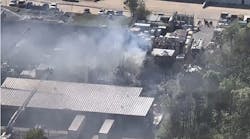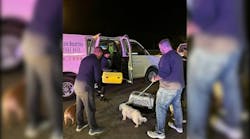Editor's note: On July 1, 1988, five Hackensack, NJ, firefighters were killed in the collapse of a wooden bow string truss roof at a fire involving an auto dealership. Firehouse® presented three stories on the disaster in the following 16 months. Now, Firehouse® reviews the fire, investigations, conclusions and recommendations made. We also examine the progress and accomplishments of not only Hackensack , but those made by other departments since the tragedy. This fire was a traumatic experience for firefighters and their families. The scars may never heal, but if we can learn from the past it is our intent to prevent such occurrences.
The fire was reported in the attic of an auto dealership. As companies stretched hoselines and attempted entry into the truss loft, the roof was being vented. Because of a delay in gaining access to the truss loft because of illegal storage, heavy fire burned through the roof. The wooden bow string truss roof collapsed. Three firefighters were killed immediately. Two other firefighters were trapped and radioed for help. They died before help could ascertain their location.
Critique
Four investigations were conducted into the cause origin, tactics and inspection practices at the fire. These were conducted by the Bergen County Prosecutor's Office, National Fire Protection Association (NFPA), consultant David Demers hired by IAFF Local 2081 of Hackensack and the New Jersey Bureau of Fire Safety. From the various reports and investigations among the contributing factors to the deadly fire were:
- Wooden bowstring truss roof.
- Substantial storage of combustible materials in the truss space.
- Added weight to truss.
- Hazard of wood truss design and failure to recognize earlier tragedies.
- Lack of fire detection equipment in truss space, delayed alarm.
- Failure to recognize truss roof.
- Lack of effective communications on the fireground and at headquarters.
- Lack of available manpower to mount an effective rescue effort after the collapse.
- No effective fireground command structure, both before the collapse and after during rescue attempts.
- Only one radio frequency for dispatching additional alarms, recalling off-duty personnel and fireground communications, especially calls for help from trapped personnel.
- Personal alert safety system (PASS) devices were not available.
Since The Fire
Weeks after the fire, the firefighters union asked the city to: increase staffing from three to four on a rig, add an officer to the rescue company, purchase additional portable radios, obtain a fireground channel, purchase PASS devices for each member, increase training, adopt the incident command system and hire civilians as dispatchers to free two firefighters from dispatching duties each shift and be reassigned to firefighting.
During the following year, the city hired several firefighters, but the total strength of the department dropped. A deputy chief's rank was established. A safety committee was formed to recommend and review new procedures. A safety officer's position was created to recommend changes in tactics at fires.
The city computerized the locations of all dangerous structures and hazardous materials. A fireground channel was implemented. Additional portable radios were placed in service. The city passed an ordinance to identify all truss-roof buildings by placing emblems on the structures.
The department protects about 39,000 people at night and upwards of 120,000 during the day. Responses have increased to 4,000 fire calls and 6,000 EMS calls. The department protects over 100 multi-story buildings with 18 firefighters staffing four engines, a truck and a rescue company under the command of a deputy chief.
A city businessman donated PASS devices for each department member. The department is now using the second-generation devices and will soon go to a third version. Apparatus were in terrible shape; two engines and a truck have been purchased. One pumper is on order and two engines and a truck were refurbished. A heavy rescue was donated by Hackensack University Medical Center.
Every member has a portable radio; before the fire only the company officers had them. The department adopted the incident command system. A tactical channel may be requested. The city hired civilians to work as fire dispatchers on each shift with extra personnel to be used as floaters. The dispatchers also handle 911 calls. Additional training has been given to firefighters on building construction. Almost all firefighters have been trained to FF3 level. The department may add a training officer to continue with an additional officer and firefighter training. All firefighters have been trained to first-responder level. All apparatus carry automatic defibrillators.
All personnel protective equipment meets OSHA standards and firefighters have been issued station uniforms. Smaller, lightweight self-contained breathing apparatus (SCBA) will be implemented. Each firefighter has a personal face mask. Battalion chief's designations were changed to deputy chief. The position of chief of operations was established as an extension from the chief's office to field operations. The number of captains was increased from four to eight. The rescue company was placed in full-time service.
The latest accomplishments include a personnel accountability system as well as training in hazardous materials, confined space rescue and incident command. Reliance has grown on the use of mutual aid. The safety officer now has to be called in from home; the department would like the position to be made full time. EMS is staffed weekdays by full-time personnel from 6 A.M. until 6 P.M. and volunteers handle the rest. The use of FAST teams has been implemented and the 2 in/2 out rule is being studied.
Just about all of the challenges have been addressed, except staffing. Firefighters point out that runs have doubled in the last 10 years, but there is now less manpower than 25 years ago.
Many firefighters have retired since the fire. The tragic loss and psychological hurt have been put behind, but many firefighters and families who lost coworkers or family members will never forget. Hopefully, the lessons learned from this incident will prevent firefighters from being killed or seriously injured.





